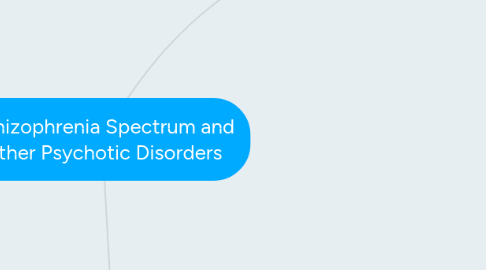
1. Key Features
1.1. Delusions
1.1.1. Types
1.1.1.1. Persecutory
1.1.1.2. Referential
1.1.1.3. Grandiose
1.1.1.4. Erotomanic
1.1.1.5. Nihilistic
1.1.1.6. Somatic
1.1.2. Specifiers
1.1.2.1. Bizarre
1.1.2.1.1. Thought Withdrawal
1.1.2.1.2. Thought Insertion
1.1.2.1.3. Delusions of Control
1.1.2.2. Non-Bizzare
1.2. Hallucinations
1.2.1. Description
1.2.1.1. Vivid and clear
1.2.1.2. With the Full Force and Impact of Normal Perceptions
1.2.1.3. Not under voluntary control
1.2.1.4. They may occur in any sensory modality
1.2.2. Types
1.2.2.1. Auditory Hallucinations
1.2.2.1.1. Usually experienced as voices, whether familiar or unfamiliar, that are perceived as distinct from the individual's own thoughts.
1.2.2.1.2. Most common in schizophrenia and related disorders.
1.2.2.2. Visual
1.2.2.3. Olfactoral
1.2.3. Diagnosing
1.2.3.1. Must occur in the context of a clear sensorium
1.2.3.1.1. Hallucinations that occur while falling asleep (hypnagogic) or waking up (hypnopompic) are considered to be within the range of normal experience.
1.2.3.2. Hallucinations may be a normal part of religious experience in certain cultural contexts.
1.3. Disorganized Thinking
1.3.1. Speech
1.3.1.1. Derailment / Loose Associations
1.3.1.2. Tangential
1.3.1.3. Incoherence / "Word Salad"
1.3.2. Diagnosing
1.3.2.1. Severity Must Impair Effective Communication
1.3.2.2. The severity of the impairment may be difficult to evaluate if the person making the diagnosis comes from a different linguistic background than that of the person being examined.
1.3.3. Less severe disorganized thinking or speech may occur during the prodromal and residual periods of schizophrenia.
1.4. Grossly Disorganized or Abnormal Motor Behavior (inciuding Catatonia)
1.4.1. Manifestation
1.4.1.1. Childlike "silliness"
1.4.1.2. Unpredictable agitation
1.4.2. Problems
1.4.2.1. Goal-directed behavior
1.4.2.2. Difficulties in performing activities or daily living
1.4.3. Catatonic Behavior
1.4.3.1. Negativism
1.4.3.2. Mutism
1.4.3.2.1. rigid
1.4.3.2.2. inappropriate or bizarre posture
1.4.3.3. Stupor
1.4.3.3.1. lack of
1.4.3.4. Catatonic Excitement
1.4.3.4.1. motor activity
1.4.3.5. Other Features
1.4.3.5.1. repeated stereotyped movements
1.4.3.5.2. staring
1.4.3.5.3. grimacing
1.4.3.5.4. mustims
1.4.3.5.5. echoing of speech
1.4.3.6. Catatonic Symptoms
1.4.3.6.1. associated with schizophrenia
1.4.3.6.2. nonspecifc
1.4.3.6.3. may occur in other disorders
1.5. Negative Symptoms
1.5.1. Schizophrenia
1.5.1.1. Account for a substantial portion of the morbidity associated with schizophrenia.
1.5.1.2. Less prominent in other psychotic disorders
1.5.1.3. Two negative symptoms that are prevalent with schizophrenia
1.5.1.3.1. diminished emotional expression
1.5.1.3.2. avolition
1.5.1.4. Other Symptoms
1.5.1.4.1. alogia
1.5.1.4.2. anhedonia
1.5.1.4.3. asociality

